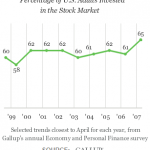The US economy is supposed to be nothing like its Chinese counterpart, a sentiment that extends in the mainstream well past that into genuine surprise about how it would be possible US financial markets tripping over Chinese stumbles. Though the US might be fighting, too, a manufacturing slump that looks more like recession every day, convention still holds that the US is on the upswing while it is China’s descent alone that troubles anyone. That was the point of Janet Yellen’s December action, to proclaim it at least in symbolic deed.
Yet, for all the supposed differences, we find policymakers on both sides of the Pacific rushing to reassure in almost the same manner as markets on both sides fail to cooperate. China has a renewed stock market problem and currency slide that makes a mockery of all its prior attempts at reassurance.
The selloff is a setback for Chinese authorities, who have been intervening to support both stocks and the yuan after the worst start to a year for mainland markets in at least two decades…
China’s domestic stock market has become one of the most visible symbols of the government’s struggle to win back investor confidence. After cheerleading by state media helped fuel an unprecedented boom in mainland shares last summer, the market crashed as regulators failed to manage a surge in leveraged bets by individual investors. While a state-sponsored market rescue campaign sparked a 25 percent rally in the Shanghai Composite, those gains were wiped out on Thursday as the index headed for the lowest close since December 2014.
Stock market concerns, as well as “dollar” currency concerns, for that matter, are being fed by increasingly difficult economic estimations. The progression of probabilities is decidedly working against the PBOC, as declared bottom after bottom falls by the wayside and all signs still point downward.
In the US, that progression is a little different but still ends with everything looking increasingly negative and seriously so. We started the year with oil at $50-some and “transitory” and the lingering effects of 5% GDP stoking only hugely positive expectations. The year ended in almost opposite shape, with oil now threatening instead below $30, an all-but-declared manufacturing recession and still more dire threats to broad economic function yet to be unleashed (an inventory problem, primary among them, that by all orthodox count shouldn’t exist under such strong conditions). As such, the Fed raised its interest rate target along with several of its ineffective toys, but rather than markets here rallying around that view they have still moved highly contrary.











Leave A Comment